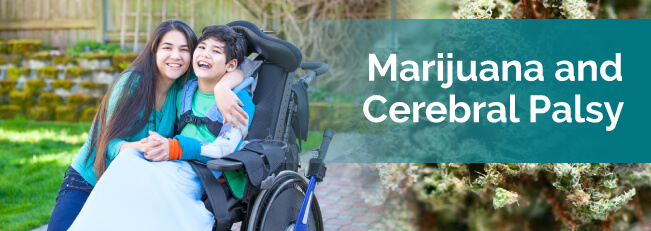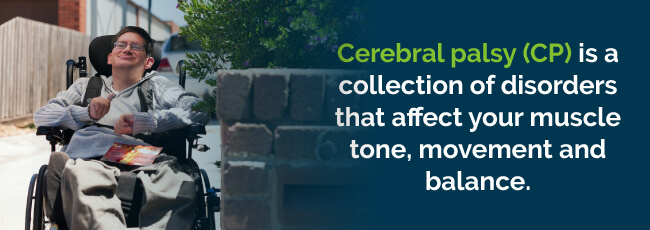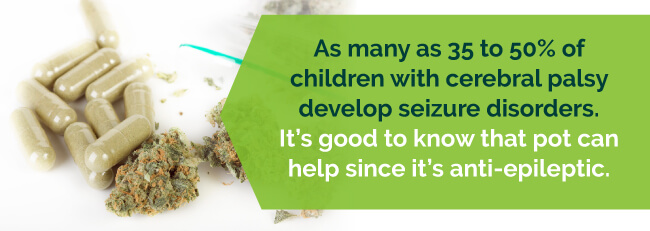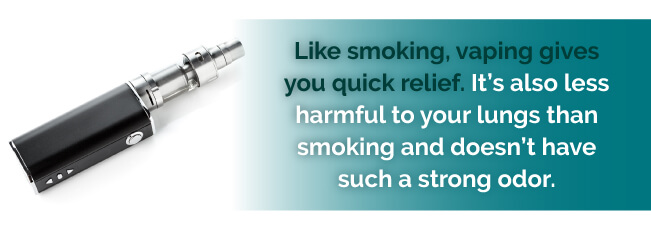
If you have cerebral palsy, it’s likely that you’ve considered alternative methods of managing the symptoms of your condition. Recently, there has been much in the press about the use and legalization of medical marijuana for many chronic health conditions, including cerebral palsy. Below, we’ll look at what cerebral palsy is, current treatments and their side effects and how medical marijuana for cerebral palsy can potentially help.
Cerebral palsy (CP) is a collection of disorders that affect your muscle tone, movement and balance. It also has an impact on your balance, posture, oral motor functioning, fine motor skills and gross motor skills. The term “cerebral” indicates that the condition is brain-related. “Palsy” relates to a muscle problem or weakness.

It is a group of non-progressive and non-contagious motor conditions that cause physical disability in human development. Cerebral palsy primarily affects various areas of bodily movement. This condition is caused by damage to the motor control centers of the developing brain and can occur during pregnancy, during childbirth or even after birth up until the age of three years old. Results of cerebral palsy are limited movement, poor posture, disturbances of sensation, depth perception and other sight-based perceptual problems.
CP is considered to be a neurological disorder caused by a brain malformation or non-progressive brain injury that happens while a child’s brain is developing. CP damage can occur while a child is in the womb, during birth or immediately after birth. Injury, infections, premature birth, accidents, negligence, medical malpractice and abuse are some of the risk factors known to lead to CP.
Back in the mid-1800s, Dr. William John Little, an English surgeon, pioneered cerebral palsy’s study. The physician drew on his experiences with his childhood disability for inspiration. Later, and decades before the medical field accepted the concept, Dr. Sigmund Freud suggested that CP could be the result of abnormalities in fetal development.
In 1948, Jack Hausman, his wife Ethel and Leonard H. Goldenson and his spouse Isabelle set out to create the United Cerebral Palsy Association (UCP). Before this time, there were few options for people with CP and their families. In those days, both the public and the medical community were fearful and didn’t understand the condition — so much so that it was commonplace for healthcare professionals to recommend that CP children be segregated from society and institutionalized. With the help of the UCP, parents and CP individuals had a new lifeline.
In 1952, a book called “Karen,” hit the New York Times bestseller list, continuing to bring CP into the national spotlight. The book was written by Marie Killilea and was based on a true story about her daughter’s life with cerebral palsy. “Karen” is still in print today.
Since then, there have been breakthroughs in the field of cerebral palsy research, and the condition continues to be studied.
All types of cerebral palsy can be characterized best by abnormal muscle tone, reflexes, motor development and coordination. In particular cases, there can be joint and bone deformities and contractures. The classical symptoms associated with cerebral palsy are spasticities, spasms, other involuntary movements, unsteady gait, problems with balance and decreased muscle mass.
Symptoms of cerebral palsy vary from person to person. Every case of CP is unique to the individual. Coordination, movement and related issues you may suffer from if you have CP include:
A cerebral palsy disability may affect your entire body. It could also be primarily limited to just one side or one limb. The brain disorder of CP itself doesn’t change over time, but the symptoms could worsen — particularly symptoms like muscle rigidity and shortening. The brain anomalies related to cerebral palsy may also bring on further neurological problems. Because of this, you may also have:
You or your loved one may have difficulty dealing with one or more of these symptoms. If you’re finding that conventional treatments are not working well for you, perhaps pot can help.
Depending on your symptoms, cerebral palsy can be debilitating. As well as the physical problems you face, you’ll likely also be feeling frustrated, angry and down. It’s crucial to enjoy the best quality of life you can, which can involve traditional medications, complementary therapies, medical cannabis for cerebral palsy and more.
These statistics will provide you with more information on cerebral palsy and its prevalence today:

Whether you’re an adult with the condition or have a child who has cerebral palsy, you or they need long-term care from a full team of medical professionals, which may include physical therapists, surgeons, mental health specialists, social workers, marijuana doctors and more.
Medications are used to treat muscle tightness. They may also work on other symptoms like spasticity complications and pain, as well as to improve your general physical functioning. The drugs you take are dependent on the problems you or your loved one are experiencing. These symptoms include isolated spasticity and generalized spasticity:
If spasticity is isolated to one group of muscles, you may receive Botox injections into your nerve, muscle or both. These injections may also help with drooling and are needed every three months. Unfortunately, these injections may cause severe weakness, bruising, mild flu-like symptoms and pain. More severe problems could include difficulties swallowing and breathing.
If your entire body is affected, your physician may prescribe you with oral muscle relaxants for relief. These include:
There are nondrug therapies available to help you if you have CP. These include physical therapy where you engage in exercises, muscle training and occupational therapy where you use adaptive equipment like electric wheelchairs, walkers and quadrupedal canes.
You may also attend speech and language therapy and recreational therapy to promote your speech, motor skills and sense of emotional well-being.
If you have bone abnormalities or muscle tightness, sometimes surgery is an option. Orthopedic surgery may correct severe deformities and help you live a more comfortable life. In some very severe cases when other treatment avenues have been exhausted, nerves may be surgically severed to relax your muscles and reduce pain. This procedure can cause numbness in some cases.
Although research into the effects of medical marijuana/cannabis for cerebral palsy is still in its infancy, there are some promising indications that weed can help.
A study of pain treatments published in the American Journal of Physical Medical Rehabilitation for people with cerebral palsy found that pot provided them with the most relief. Although this was the case, less than five percent of the people surveyed had ever used cannabis to treat their pain.
Another study published in Reviews in Neurological Diseases found that a 45-year-old male with epilepsy and CP showed a distinct improvement through using marijuana.
Marijuana/cannabis and cerebral palsy are compatible regarding treatment. Cannabis has been shown to be effective for treating various symptoms of cerebral palsy, including:

As pot is natural and has a relatively low side effect profile, medical marijuana could be an effective therapeutic add on to your treatment plan.
There are many strains of medical cannabis available from dispensaries today. All have different therapeutic effects. If you’re unsure which ones could work for you, you can speak to a marijuana doctor or a budtender at your dispensary. To get you started, we’ve compiled a short list to help:
Cannabis can significantly aid you in enjoying a better quality of life. The strains that will help you most depend on your symptoms:
There are many different ways you can take medical pot for you or your loved one’s cerebral palsy symptoms, including:

To date, many states have approved medical marijuana for certain qualifying conditions, including pain, muscle spasms, seizures and insomnia.
Medical marijuana is a great treatment option for those who suffer from cerebral palsy, mainly because of its direct ability to alleviate spasticity symptoms. Medical marijuana serves as a muscle relaxer and can also provide exceptional anti-inflammatory properties you can’t find anywhere else. This type of alternative treatment option also alleviates chronic pain associated with CP as well as any form of stiffness.
If you or a loved one is looking to find relief from symptoms of cerebral palsy, MarijuanaDoctors.com can help. We can connect you with hundreds of quality marijuana doctors working with cerebral palsy patients across the country in all legal marijuana states and ensure you are in compliance with your state laws. Search for a marijuana doctor or dispensary today and let us help improve your quality of life!
For more information about how cannabis can be used to treat Cerebral Palsy, check out our resources:
Find A Doctor Find A Dispensary